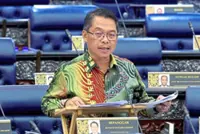Half of Sabah's land area is suitable for the Sunda pangolin, a totally protected species, but most of it is accessible to poachers. – Photo: Lim Jia Zhen/Danau Girang Field Centre.
KOTA KINABALU: Sabah's forests are ideal sanctuary for the endangered Sunda pangolin (Manis javanica) but there is an urgent need for protection strategies for the mammals, according to a study published in Global Ecology and Conservation journal.
The study found that about half of Sabah's land area or approximately 39,530sq km was a suitable habitat for the animal.
However, there was also a constant threat from poaching because of high demand for pangolins, worsened by habitat loss and fragmentation that increased their vulnerability.
The researchers conducted the study as part of a state-wide high conservation value (HCV) assessment, partly for rare, threatened and endangered species.
They aimed to identify key areas crucial for the pangolin's preservation and suggested targeted conservation strategies to protect these ecosystems.
Despite being the most trafficked mammal in the world, pangolins could find a vital refuge in Sabah's natural forests as a safeguard for their survival, the study added.
Pangolins were unique among mammals for their scale-covered bodies, which unfortunately make them a target for poachers.
The scales were used in traditional medicine while pangolin meat was considered a delicacy in some Asian communities.
According to the study, a significant portion of pangolin habitat was accessible to poachers and there was an urgency to create sanctuaries to protect the endangered mammal.
Lead author Elisa Panjang, a PhD student at Danau Girang Field Centre (DGFC) and Cardiff University, said the study highlights a worrying fact: that 91% of the suitable habitat area is easily accessed by poachers.
"This accessibility ... also hinders the pangolins' chances for natural recovery," she said, adding that enhanced protective measures and effective management strategies were also needed.
DGFC director Prof Benoit Goossens, a co-author of the study, said the findings provided a roadmap for where conservation efforts are most needed.
"Our study advocates strict monitoring and law enforcement within these vulnerable habitats to prevent illegal activities and highlights the resilience and adaptability of Sunda pangolins in non-forest habitats, such as oil palm plantations or urban areas.
"Therefore, conservation efforts need to be boosted, particularly in areas with suitable but unprotected habitats," Prof Goossens said.
Dr Nicola Abram, who led mammal species mapping for Sabah's state-level HCV assessment, said expanding totally protected areas and implementing sustainable land-use practices were crucial.
"Through important collaborations with institutions and scientists, we have gathered one of the most comprehensive databases on threatened mammals to guide conservation priorities and actions for some of Sabah's most vulnerable wildlife," she added.





